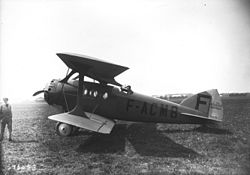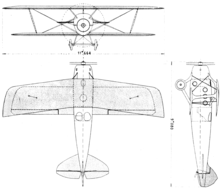Blériot-SPAD page 33
| Blériot-SPAD page 33 | |
|---|---|

|
|
| Type: | Airliner |
| Design country: | |
| Manufacturer: | |
| First flight: |
December 12, 1920 |
| Number of pieces: |
43 |
The Blériot-SPAD S.33 was a rated for four to five passengers biplane - passenger aircraft of the French manufacturer Blériot Aéronautique from the 1920s.
history
The S.33 took off for the first time on December 12, 1920. Since some of the then still young airlines showed interest in the S.33, a further 41 copies were built after the two pre-series machines.
The French company Compagnie Franco-Romaine received 20 machines and used them between France and Eastern Europe. In 1925 this company became the CIDNA (Compagnie Internationale De Navigation Aérienne), which in 1933 merged with other companies to form Air France . The S.33 were used at times as far as Istanbul .
During the 1930s, the S.33 and its variants were the standard passenger aircraft of some small European airlines.
construction
The Blériot-SPAD S.33 was a single-handled double-decker. The lower wings were made shorter than the upper, the upper wings were heavily swept, the lower, however, were at right angles to the fuselage. The ailerons were on the lower wings. The machine had a two-wheeled chassis and a tail spur.
The S.33 was designed for four passengers who had wicker chairs in the closed cabin in the fuselage. The passengers had a view of the outside through three portholes on each side of the fuselage. A fifth passenger could take a seat next to the pilot in the open cockpit . The cockpit was roughly in the middle of the fuselage behind the passenger cabin.
The prototype was still equipped with a Salmson radial engine with an output of 184 kW (250 PS ). The series models received the 7 kW more powerful Salmson C.9 radial engine.
variants
- Blériot-SPAD p.46 : Modification of the S-33 with a Lorraine-Dietrich engine 12 Da with 272 kW (370 hp) and an increase in the wingspan to 12.60 m; First flight on June 16, 1921; 38 machines sold to the Compagnie Franco-Romaine.
- Blériot-SPAD p.48 : For testing purposes, a series-produced S.33 was equipped with a 202 kW (275 PS) Lorraine-Dietrich engine; this machine was given the name S.48 during this time.
- Blériot-SPAD p.50 : Blériot created two prototypes based on the p.33 with the Hispano-Suiza-8Fb engine with an output of 221 kW (300 PS), then 3 machines of the type S.33 from the company CMA were made accordingly motorized and redrawn on page 48. Another machine was equipped with the enlarged structure of the S. 46 and flew in government services.
- Blériot-SPAD p.66 : In 1925 Compagnie Franco-Romaine became CIDNA (see above). The 34 S.46 still in service with this company at that time received fur-covered headrests for the seats in the cockpit. In addition, 8 machines of the type S.33 of this company were brought to the same standard. The total of 42 machines have been redrawn on page 66.
- Blériot-SPAD p.86 : Single copy of a p.66 equipped with a Lorraine-Dietrich engine with an output of 331 kW (450 hp) in 1925
- Blériot-SPAD S.116 : Unique piece of a S.66 from 1928 (serial number 32) with a Renault 12.Ia with 331 kW (450 S)
- Blériot-SPAD C.128 : Renewed redesignation of page 86 after the conversion to a Hispano-Suiza engine, type 12 Ha with 331 kW (450 PS) - later known as page 126
- Blériot-SPAD p.126 : see Blériot-SPAD C.128
see also: Blériot-SPAD page 56
Technical specifications
| Parameter | Data |
|---|---|
| crew | 1 |
| Passengers | 4 or 5 |
| length | 9.08 m |
| span | 11.66 m |
| height | 3.20 m |
| Wing area | 42.18 m² |
| Empty mass | 1050 kg |
| Takeoff mass | 2062 kg |
| Cruising speed | 160 km / h |
| Top speed | 180 km / h |
| Service ceiling | 3800 m |
| Range | 1080 km |
| Engines | a Salmson -CM.9- radial engine with 191 kW (260 PS) |
Web links
- Photo and information on aviastar.org (English)
